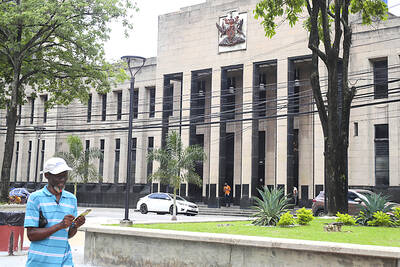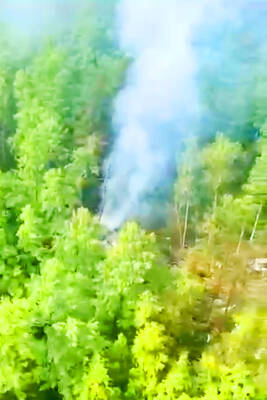Life on Earth may have sparked into existence as early as 4.4 billion years ago, hundreds of millions of years earlier than previously thought possible, a study to be published today says.
Until now scientists assumed that no life forms could have survived the so-called Late Heavy Bombardment, a 100-million-year fusillade during which our young planet was pummeled by meteorites that blasted craters the size of Thailand and France.
All told, some 2 quadrillion tonnes of space rock rained down on the planet, the new study says.
Heat generated by this relentless pounding was intense enough to melt much of Earth’s surface, rendering it uninhabitable even for primitive life forms that thrived at high temperatures.
That, at least, has been the conventional wisdom, bolstered by the fact that the earliest traces of life discovered so far appeared shortly after the extraterrestrial onslaught tapered off 3.9 billion years ago.
Fossils reveal microscopic life forms 3.5 billion years old, and geochemical clues point to more primitive organisms — thought by some to be the common ancestor to all things living — 300,000 million years before that.
But Stephen Mojzsis and Oleg Abramov of the University of Colorado argue that early Earth wasn’t so hellish after all.
Many life forms that might have arisen earlier could well have survived the bombardment, according to their study, published in Nature.
Using numerical models of impact-generated heat in Earth’s crust, they show that no more than 37 percent of the planet’s surface was sterilized at any given time, and that only 10 percent reached temperatures above 500°C.
That is very hot, but much of Earth was cool enough to accommodate different families of microbes able to take the heat, 20°C to 50°C for some, and beyond the boiling point — up to 110°C — for others.
Some microbes would also have been able to live several kilometers below Earth’s surface, much as some simple life forms do today, the study points out.
“Our analysis shows that there is no plausible situation in which the habitable zone was fully sterilized on Earth,” Mojzsis said.
“All the criteria necessary for life” — liquid water, energy sources such as sunlight and chemical building blocks from meteors or Earth itself — “were present at least since 4.38 billion years ago,” he said by e-mail.
“The antiquity of life may not be very much less than the Earth itself,” he said.
Research published last week shows how a series of chemical reactions on early Earth could have produced ribonucleic acid, or RNA, a single-stranded cousin of the DNA that is the blueprint for all life.
Pushing back the date at which self-replicating life forms first emerged from the primordial soup would also explain how the relatively complex organisms that fossils records show existed 3.5 to 3.8 billion years ago could have had time to evolve.
In a commentary, also published in Nature, Lynn Rothschild of the NASA Ames Research Center in California says the new study convincingly shows how life may have emerged sooner rather than later.
“Moreover, it opens the possibility that life arose on Earth only once, and that the planet has been continuously inhabited ever since,” she said.
Mojzsis is less inclined to think that everything within the realm of biology can be traced back to a single so-called “last universal common ancestor.”
“Instead, they might have been a community of co-evolving proto-organisms that crystallized into a population” of primitive cells, he said.
Answering once-and-for-all the question of whether life happened more than 4 billion years ago will be extremely difficult, scientists say. So much of the evidence — if there is any — was destroyed during Earth’s fiery baptism that finding intact traces may be futile. The earliest sedimentary rock ever found is “only” 3.83 billion years old.

Trinidad and Tobago declared a new state of emergency on Friday after authorities accused a criminal network operating in prisons across the country of plotting to kill key government officials and attack public institutions. It is the second state of emergency to be declared in the twin-island republic in a matter of months. In December last year, authorities took similar action, citing concerns about gang violence. That state of emergency lasted until mid-April. Police said that smuggled cellphones enabled those involved in the plot to exchange encrypted messages. Months of intelligence gathering led investigators to believe the targets included senior police officers,

FOREST SITE: A rescue helicopter spotted the burning fuselage of the plane in a forested area, with rescue personnel saying they saw no evidence of survivors A passenger plane carrying nearly 50 people crashed yesterday in a remote spot in Russia’s far eastern region of Amur, with no immediate signs of survivors, authorities said. The aircraft, a twin-propeller Antonov-24 operated by Angara Airlines, was headed to the town of Tynda from the city of Blagoveshchensk when it disappeared from radar at about 1pm. A rescue helicopter later spotted the burning fuselage of the plane on a forested mountain slope about 16km from Tynda. Videos published by Russian investigators showed what appeared to be columns of smoke billowing from the wreckage of the plane in a dense, forested area. Rescuers in

A disillusioned Japanese electorate feeling the economic pinch goes to the polls today, as a right-wing party promoting a “Japanese first” agenda gains popularity, with fears over foreigners becoming a major election issue. Birthed on YouTube during the COVID-19 pandemic, spreading conspiracy theories about vaccinations and a cabal of global elites, the Sanseito Party has widened its appeal ahead of today’s upper house vote — railing against immigration and dragging rhetoric that was once confined to Japan’s political fringes into the mainstream. Polls show the party might only secure 10 to 15 of the 125 seats up for grabs, but it is

Philippine President Ferdinand Marcos Jr is to meet US President Donald Trump this week, hoping Manila’s status as a key Asian ally would secure a more favorable trade deal before the deadline on Friday next week. Marcos would be the first Southeast Asian leader to meet Trump in his second term. Trump has already struck trade deals with two of Manila’s regional partners, Vietnam and Indonesia, driving tough bargains in trade talks even with close allies that Washington needs to keep onside in its strategic rivalry with China. “I expect our discussions to focus on security and defense, of course, but also